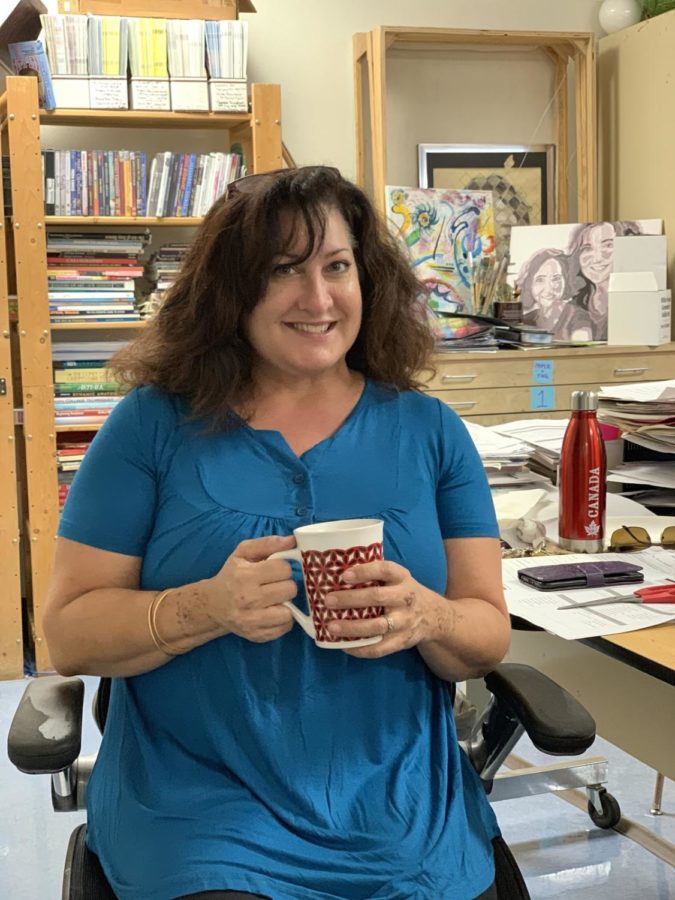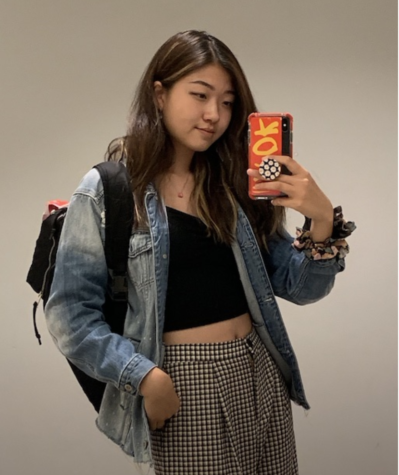The Condemnation of AP/IB Art: 5 Courses, 1 Period
Picture by Sheehwa You
Mrs. Dhillon
September 17, 2019
Have you ever bitten off more than you could chew? Did the painful attempt to gnaw at the mouthful of caramel taffy, which stuck to gums, syrup-ed spit, and strained jaw muscles, ever supersede the worth of its rich sweetness? Did the big bite then turn around and bite back?
Then tell me, why kill two birds with one stone when you could kill five?
It is nothing new to note the overpopulation of the school, the packed-to-the-brim classrooms, the overextended students and staff, so on and so forth… But, what would you say if I told you that one of the teachers on campus is in charge of instructing five different classes in a single period?
Such is the plight of Mrs. Dhillon, an art teacher at Quartz Hill, in charge of teaching seven classes: Art 2, Drawing 1, AP 2D Design, AP 3D Design, AP Drawing, IB Visual Arts HL1, and IB Visual Arts HL2. The hardest part of her job? Teaching all five AP/IB courses within her sixth period alone.
This is the first year that Mrs. Dhillon was expected to tackle such a task, as she had previously only taught Art 1, Art 2, and the International Baccalaureate classes. Prior to this year, her combined periods had only consisted of two classes maximum.
Mrs. Dhillon expressed that her biggest concern with the dynamic of the class is that she is being stretched too thin. She acknowledges the fact that the IB courses are considered a higher level, and thus require more individualistic instruction and feedback in order to cultivate the necessary skills to pursue the IB Diploma. This personal attendance, however, is extremely difficult to provide considering the need to satisfy five different curriculums within an hour.
Considering this new beast of a period, Mrs. Dhillon decided to prepare syllabi and course schedules before school started and pass them out to the class. These outline the current and projected assignments as well as important submission dates in an attempt to combat disorganization and promote self-direction, hopefully sparing Mrs. Dhillon the time of running around the classroom from AP 2D to IB HL1 to IB HL2 to AP 3D…
Luckily enough, she expresses that the AP art courses are fundamentally similar, all requiring sustained investigations and submitted works at around the same time. Mrs. Dhillon states that she is constantly seeking new ways to bridge the courses into a common lesson that addresses the needs of all. Students also have helpful online resources, such as the official AP and IB websites, to assist them throughout the year.
However, though the class seems to be running relatively smoothly so far, it must be noted that instructing so many demanding classes within an hour must be an extremely stressful and exhausting challenge for any teacher. Furthermore, it might also be an annoyance to the students who must wait between the lectures of other classes to receive further instructions for their own projects.
Mrs. Dhillon did not ask to undertake this chaos, an environment in which she said she would “never get used to,” no matter how many years she is asked to teach.
And so, the index fingers instinctually point yet again to the administration for the “Who is to blame for this mess?” The reasoning for this class structure is seemingly what it usually is: an attempt to save money. However, an interview with Principal Mercier reveals otherwise.
According to Mr. Mercier, the under-enrollment of the AP and IB art classes led administration to only two real options: combine classes or cancel them altogether. Though, they are definitely hesitant to do the latter without thoughtful consideration, as Mr. Mercier stressed that the school’s administration strives to provide every student with the opportunity to pursue their preferred course rather than removing the class.
Further, the removal of such classes would be devastating for students seeking advanced instruction. IB students would be completely stripped of their elective options, as they are currently only provided with either IB Visual Arts or IB Psychology: a sad array of two choices. Not to mention that the school would lose three AP art classes… As if the creative bone in Quartz Hill was not shattered enough.
Though the strategy to save under-enrolled courses by amassing them into a mega-class ruled by one teacher (thereby ensuring the survival of each) sounds doable on paper, this solution blazes beyond the nuances of reality – an exhausted and overwhelmed teacher, students receiving 1⁄5 of the individual time they should spend with their instructor, and students dropping the class after realizing that it will essentially be a year-long balancing act for the teacher.
Though, this is not the first year that such a structure was attempted. Mrs. Miller, another art teacher at Quartz Hill High School, taught the AP and IB Visual Arts courses as a combined class a few years ago. She now teaches the Art 1 and Art 2 classes that Mrs. Dhillon was once assigned to.
Essentially, such a class makes it not only difficult for the students to learn, but also for the instructor to teach. The environment takes a toll on both parties, wearing each away as the year progresses and the responsibilities pile up. Though the logic behind the combination of under-enrolled classes is reasonable, merging five classes into one is excessive and may cause more harm than good. Already, the class is almost half the size it was during the first week of school as students, discouraged by the chaotic setting, decided to drop the class entirely. This by no means is a suggestion that the better solution is to cancel the classes. Instead, this article merely seeks to pose the question, “At what cost?”




